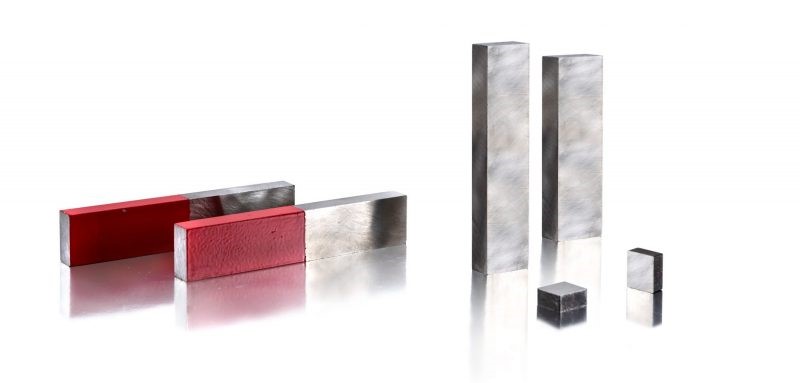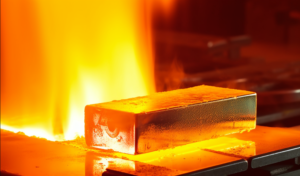Alnico magnets, made primarily of aluminum, nickel, and cobalt, are known for their unique combination of impressive features, such as high-temperature stability, corrosion resistance, and strong magnetic properties. These characteristics make Alnico magnets an ideal choice for a diverse array of industries, including aerospace, automotive, music and audio, medical, and industrial sectors.
EPI Magnets has been a leader in the magnetic industry for over 20 years, providing clients with reliable and economical magnetic solutions tailored to their needs. Our expertise in Alnico magnets, a classic and versatile choice in magnet materials, allows us to offer a wide range of high-quality products that deliver exceptional performance across various applications.
We offer both Cast and Sintered Alnico Magnets, allowing you to choose the ideal type for your specific application.
The grade range for AlNiCo magnets spans from 2.0 MGOe to 9.0 MGOe. The most commonly used grades are AlNiCo5 and AlNiCo6. Sintered AlNiCo8, sintered AlNiCo6, and sintered AlNiCo5 are suitable for applications with smaller and less complex geometric shapes.
| Grade | MMPA | Br | Hcb | (BH)max | Tc | Tw | T.C. a(Br) | T.C.a(Hcj) |
| mT / Gs | kA/m / Oe | kJ/m3 / MGOe | ℃ | ℃ | %/℃ | %/℃ | ||
| FLN8 | S.ALNICO3 | 500 / 5000 | 40 / 500 | 8 / 1.00 | 760 | 450 | -0.02 | -0.03~+0.03 |
| FLNG12 | S.ALNICO2 | 650 / 6500 | 48 / 600 | 12 / 1.50 | 800~850 | 450 | -0.02 | -0.03~+0.03 |
| FLNGT18 | S.ALNICO7 | 600 / 6000 | 90 / 1130 | 18 / 2.20 | 800~850 | 450 | -0.02 | -0.03~+0.03 |
| FLNG34 | S.ALNICO5 | 1200 / 12000 | 48 / 600 | 34 / 4.25 | 800~850 | 450 | -0.02 | -0.03~+0.03 |
| FLNGT28 | S.ALNICO6 | 1050 / 10500 | 56 / 700 | 28 / 3.50 | 800~850 | 450 | -0.02 | -0.03~+0.03 |
| FLNGT38 | S.ALNICO8 | 800 / 8000 | 110 / 1300 | 38 / 4.75 | 800~850 | 450 | -0.02 | -0.03~+0.03 |
| FLNGT42 | S.ALNICO8 | 850 / 8500 | 120 / 1500 | 42 / 5.25 | 800~850 | 450 | -0.02 | -0.03~+0.03 |
| FLNGT33J | S.ALNICO8HC | 700 / 7000 | 140 / 1750 | 33 / 4.13 | 800~850 | 450 | -0.02 | -0.03~+0.03 |
| Grade | MMPA | Br | Hcb | (BH)max | Tc | Tw | T.C a(Br) | T.C.a(Hcj) |
| mT / Gs | kA/m / Oe | k/m3 / MGOe | ℃ | ℃ | %/℃ | %/℃ | ||
| LN10 | ALNICO3 | 600 / 6000 | 40 / 500 | 10 / 1.25 | 750 | 550 | -0.02 | -0.03~+0.03 |
| LNG10 | 600 / 6000 | 44 / 550 | 10 / 1.25 | 750 | 550 | -0.02 | -0.03~+0.03 | |
| LNG12 | ALNICO2 | 700 / 7000 | 44 / 550 | 12 / 1.50 | 800~850 | 550 | -0.02 | -0.03~+0.03 |
| LNG13 | 680 / 6800 | 48 / 600 | 13 / 1.63 | 800~850 | 550 | -0.02 | -0.03~+0.03 | |
| LNG16 | ALNICO4 | 800 / 8000 | 48 / 600 | 16 / 2.00 | 800~850 | 550 | -0.02 | -0.03~+0.03 |
| LNG18 | 900 / 9000 | 48 / 600 | 18 / 2.25 | 800-850 | 550 | -0.02 | -0.03~+0.03 | |
| LNG37 | ALNICO5 | 1200 / 12000 | 48 / 600 | 37 / 4.63 | 800~850 | 550 | -0.02 | -0.03~+0.03 |
| LNG40 | 1230 / 12300 | 48 / 600 | 40 / 5.00 | 800~850 | 550 | -0.02 | -0.03~+0.03 | |
| LNG44 | 1250 / 12500 | 52 / 650 | 44 / 5.50 | 800~850 | 550 | -0.02 | -0.03~+0.03 | |
| LNG48 | ALNICO5DG | 1280 / 12800 | 56 / 700 | 48 / 6.00 | 800~850 | 550 | -0.02 | -0.03~+0.03 |
| LNG52 | 1300 / 13000 | 56 / 700 | 52 / 6.50 | 800~850 | 550 | -0.02 | -0.03~+0.03 | |
| LNG56 | ALNICO5-7 | 1300 / 13000 | 58 / 720 | 56 / 7.00 | 800~850 | 550 | -0.02 | -0.03~+0.03 |
| LNG60 | 1330 / 13300 | 60 / 750 | 60 / 7.50 | 800~850 | 550 | -0.02 | -0.03~+0.03 | |
| LNGT28 | ALNICO6 | 1000 / 10000 | 56 / 700 | 28 / 3.50 | 800~850 | 550 | -0.02 | -0.03~+0.03 |
| LNGT30 | 1100 / 11000 | 56 / 700 | 30 / 3.75 | 800-850 | 550 | -0.02 | -0.03~+0.03 | |
| LNGT18 | ALNICO8 | 580 / 5800 | 80 / 1000 | 18 / 2.25 | 800~850 | 550 | -0.02 | -003~+0.03 |
| LNGT32 | 800 / 8000 | 100 / 1250 | 32 / 4.00 | 800~850 | 550 | -0.02 | -0.03~+0.03 | |
| LNGT38 | 800 / 8000 | 110 / 1380 | 38 / 4.75 | 800-850 | 550 | -0.02 | -0.03~+0.03 | |
| LNGT44 | 850 / 8500 | 115 / 1450 | 44 / 5.50 | 800~850 | 550 | -0.02 | -0.03~+0.03 | |
| LNGT48 | ALNICOBHE | 900 / 9000 | 120 / 1500 | 48 / 6.00 | 800~850 | 550 | -0.02 | -0.03~+0.03 |
| LNGT60 | ALNICO9 | 900 / 9000 | 110 / 1380 | 60 / 7.50 | 800~850 | 550 | -0.02 | -0.03~+0.03 |
| LNGT72 | 1050 / 10500 | 112 / 1400 | 72 / 9.00 | 800~850 | 550 | -0.02 | -0.03~+0.03 | |
| LNGT80 | 1080 / 10600 | 120 / 1500 | 80 / 10.00 | 800~850 | 550 | -0.02 | -0.03~+0.03 | |
| LNGT88 | 1100 / 11000 | 115 / 1450 | 88 / 11.00 | 800-850 | 550 | -0.02 | -0.03~+0.03 | |
| LNGT96 | 1150 / 11500 | 118 / 1480 | 96 / 12.00 | 800-850 | 550 | -0.02 | -0.03~+0.03 | |
| LNGT36J | ALNICOBHC | 700 / 7000 | 140 / 1750 | 36 / 4.50 | 800~850 | 550 | -0.02 | -0.03~+0.03 |
| LNGT48J | 800 / 8000 | 145 / 1820 | 48 / 6.00 | 800-850 | 550 | -0.02 | -0.03~+0.03 | |
| LNGT52J | 850 / 8500 | 140 / 1750 | 52 / 6.50 | 800~850 | 550 | -0.02 | -0.03~+0.03 |

Alnico magnets are well-known for their exceptional corrosion resistance, which is a result of their unique composition, primarily consisting of aluminum, nickel, and cobalt, along with other elements such as copper and titanium. This inherent resistance to corrosion ensures that Alnico magnets can maintain their performance and magnetic properties even in challenging environments, without the need for additional protective coatings or plating.
However, there are situations where surface treatments may be necessary or beneficial for Alnico magnets. Some of these application-specific requirements include:
Alnico magnets boast excellent temperature stability, maintaining their magnetic properties in temperatures ranging from cryogenic levels to as high as 930°F (500°C). They offer excellent stability with respect to temperature changes and experience minimal strength reduction when heated. At temperatures exceeding 1000°F (538°C), metallurgical changes may cause magnetic strength to reduce rapidly.

When working with Alnico magnets, it’s important to take their mechanical properties into account to ensure optimal performance and cost-effectiveness. These magnets are coarse-grained, hard, and brittle, which makes them unsuitable for conventional drilling methods. However, innovative processes, have made it possible to drill Alnico magnets when necessary.
Given their mechanical characteristics, Alnico magnets are not typically used as structural components in product designs. Here are some design recommendations to consider when incorporating Alnico magnets into your application:
By considering these design guidelines when working with Alnico magnets, you can ensure a successful integration of the magnet into your application while maximizing performance, reliability, and cost-effectiveness.
Alnico magnets are used in a broad array of industries and applications, including:
We will contact you within 1 working day. You can also contact us by sending emails directly to sales@epimagnets.com.